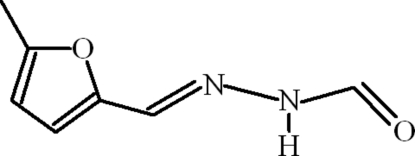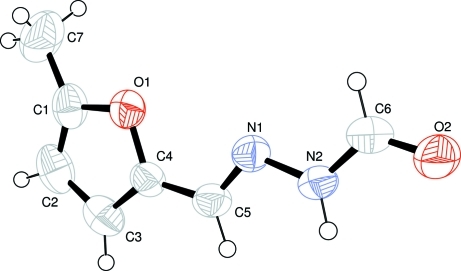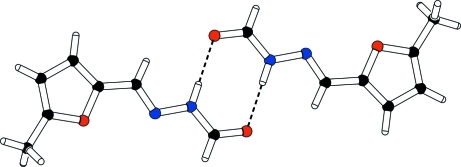Abstract
The title compound, C7H8N2O2, is almost planar (r.m.s. deviation for non-H atoms = 0.029 Å). In the crystal, inversion dimers linked by pairs of N—H⋯O hydrogen bonds generate an R 2 2(8) ring motif.
Related literature
For related structures, see: Shafiq et al. (2009 ▶); Bai & Jing (2007 ▶); Yao & Jing (2007 ▶). For graph-set notation, see: Bernstein et al. (1995 ▶).
Experimental
Crystal data
C7H8N2O2
M r = 152.15
Orthorhombic,

a = 10.6433 (14) Å
b = 6.7762 (8) Å
c = 21.129 (3) Å
V = 1523.9 (3) Å3
Z = 8
Mo Kα radiation
μ = 0.10 mm−1
T = 296 K
0.25 × 0.15 × 0.13 mm
Data collection
Bruker Kappa APEXII CCD diffractometer
Absorption correction: multi-scan (SADABS; Bruker, 2005 ▶) T min = 0.985, T max = 0.988
7485 measured reflections
1403 independent reflections
655 reflections with I > 2σ(I)
R int = 0.072
Refinement
R[F 2 > 2σ(F 2)] = 0.044
wR(F 2) = 0.108
S = 1.00
1403 reflections
101 parameters
H-atom parameters constrained
Δρmax = 0.12 e Å−3
Δρmin = −0.16 e Å−3
Data collection: APEX2 (Bruker, 2007 ▶); cell refinement: SAINT (Bruker, 2007 ▶); data reduction: SAINT; program(s) used to solve structure: SHELXS97 (Sheldrick, 2008 ▶); program(s) used to refine structure: SHELXL97 (Sheldrick, 2008 ▶); molecular graphics: ORTEP-3 for Windows (Farrugia, 1997 ▶) and PLATON (Spek, 2009 ▶); software used to prepare material for publication: WinGX (Farrugia, 1999 ▶) and PLATON.
Supplementary Material
Crystal structure: contains datablocks global, I. DOI: 10.1107/S1600536809037064/hb5099sup1.cif
Structure factors: contains datablocks I. DOI: 10.1107/S1600536809037064/hb5099Isup2.hkl
Additional supplementary materials: crystallographic information; 3D view; checkCIF report
Table 1. Hydrogen-bond geometry (Å, °).
| D—H⋯A | D—H | H⋯A | D⋯A | D—H⋯A |
|---|---|---|---|---|
| N2—H2A⋯O2i | 0.86 | 2.00 | 2.848 (3) | 169 |
Symmetry code: (i)  .
.
Acknowledgments
The authors acknowledge the Higher Education Commission, Islamabad, Pakistan, and Bana International, Karachi, Pakistan, for funding the purchase of the diffractometer at GCU, Lahore and for technical support, respectively.
supplementary crystallographic information
Comment
In continuation of our studies of different derivatives of formohydrazide (Shafiq et al., 2009), the title compound (I, Fig. 1), has been prepared and being reported. The metal complexes of (I) has been prepared with transition metals and their various studies are in progress.
The crystal structures of (II) (E)-4-bromo-N'-((5-methylfuran-2-yl)methylene)benzohydrazide (Bai & Jing, 2007), (III) (E)-N'-((5-methylfuran-2-yl)methylene)furan-2-carbohydrazide (Yao & Jing, 2007) have been reported which contain the 5-methylfuran-2-yl moiety as present in (I). The title compound consists of dimers due to intermolecular H-bonding of type N–H···O (Table 1, Fig. 2) forming R22(8) (Bernstein et al., 1995) ring motif. Similar bonding also exist in N'-[(1E)-1-(4-Chlorophenyl)ethylidene]formohydrazide (Shafiq et al., 2009). The overall molecule of (I) is planar with an r.m.s. deviation of 0.0285 Å.
Experimental
To a hot stirred solution of formohydrazide (1.0 g, 0.017 mol) in ethanol (10 ml) was added 5-methylfurfural (1.65 ml, 0.017 mol). The resultant mixture was then heated under reflux for 4 h and monitored through TLC. After completion of reaction, the mixture was cooled to room temperature. The crude solid was collected by suction filtration. The precipitates were washed with hot ethanol, filtered and dried. Brown needles of (I) were obtained by recrystalization from (1:1 v/v) methanol:1,4-dioxan.
Refinement
The H-atoms were positioned geometrically with N—H = 0.86, C—H = 0.93 and 0.96 Å for aryl and methyl H atoms, respectively and constrained to ride on their parent atoms, with Uiso(H) = xUeq(C,N), where x = 1.5 for methyl H and x = 1.2 for all other H atoms.
Figures
Fig. 1.
View of (I) with displacement ellipsoids drawn at the 50% probability level. H-atoms are shown by small circles of arbitrary radius.
Fig. 2.
The partial packing if (I) which shows that molecules are dimerized and form ring motifs.
Crystal data
| C7H8N2O2 | F(000) = 640 |
| Mr = 152.15 | Dx = 1.326 Mg m−3 |
| Orthorhombic, Pbca | Mo Kα radiation, λ = 0.71073 Å |
| Hall symbol: -P 2ac 2ab | Cell parameters from 1864 reflections |
| a = 10.6433 (14) Å | θ = 2.7–25.5° |
| b = 6.7762 (8) Å | µ = 0.10 mm−1 |
| c = 21.129 (3) Å | T = 296 K |
| V = 1523.9 (3) Å3 | Cut needle, brown |
| Z = 8 | 0.25 × 0.15 × 0.13 mm |
Data collection
| Bruker Kappa APEXII CCD diffractometer | 1403 independent reflections |
| Radiation source: fine-focus sealed tube | 655 reflections with I > 2σ(I) |
| graphite | Rint = 0.072 |
| Detector resolution: 7.80 pixels mm-1 | θmax = 25.5°, θmin = 2.7° |
| ω scans | h = −12→12 |
| Absorption correction: multi-scan (SADABS; Bruker, 2005) | k = −5→8 |
| Tmin = 0.985, Tmax = 0.988 | l = −23→25 |
| 7485 measured reflections |
Refinement
| Refinement on F2 | Primary atom site location: structure-invariant direct methods |
| Least-squares matrix: full | Secondary atom site location: difference Fourier map |
| R[F2 > 2σ(F2)] = 0.044 | Hydrogen site location: inferred from neighbouring sites |
| wR(F2) = 0.108 | H-atom parameters constrained |
| S = 1.00 | w = 1/[σ2(Fo2) + (0.0376P)2] where P = (Fo2 + 2Fc2)/3 |
| 1403 reflections | (Δ/σ)max < 0.001 |
| 101 parameters | Δρmax = 0.12 e Å−3 |
| 0 restraints | Δρmin = −0.16 e Å−3 |
Special details
| Geometry. Bond distances, angles etc. have been calculated using the rounded fractional coordinates. All su's are estimated from the variances of the (full) variance-covariance matrix. The cell e.s.d.'s are taken into account in the estimation of distances, angles and torsion angles |
| Refinement. Refinement of F2 against ALL reflections. The weighted R-factor wR and goodness of fit S are based on F2, conventional R-factors R are based on F, with F set to zero for negative F2. The threshold expression of F2 > σ(F2) is used only for calculating R-factors(gt) etc. and is not relevant to the choice of reflections for refinement. R-factors based on F2 are statistically about twice as large as those based on F, and R- factors based on ALL data will be even larger. |
Fractional atomic coordinates and isotropic or equivalent isotropic displacement parameters (Å2)
| x | y | z | Uiso*/Ueq | ||
| O1 | 0.56771 (16) | 0.2958 (2) | 0.15544 (8) | 0.0550 (7) | |
| O2 | 0.66434 (16) | 1.0759 (3) | 0.01153 (9) | 0.0665 (8) | |
| N1 | 0.5699 (2) | 0.6414 (3) | 0.08604 (10) | 0.0486 (8) | |
| N2 | 0.56384 (19) | 0.8059 (3) | 0.04784 (10) | 0.0497 (8) | |
| C1 | 0.5376 (3) | 0.1184 (4) | 0.18332 (14) | 0.0602 (11) | |
| C2 | 0.4218 (3) | 0.0664 (4) | 0.16579 (15) | 0.0717 (14) | |
| C3 | 0.3762 (3) | 0.2130 (4) | 0.12461 (15) | 0.0641 (11) | |
| C4 | 0.4667 (2) | 0.3504 (4) | 0.11942 (12) | 0.0481 (10) | |
| C5 | 0.4735 (2) | 0.5290 (4) | 0.08350 (13) | 0.0501 (10) | |
| C6 | 0.6618 (2) | 0.9277 (4) | 0.04483 (14) | 0.0542 (11) | |
| C7 | 0.6371 (3) | 0.0296 (4) | 0.22318 (15) | 0.0950 (16) | |
| H2 | 0.37892 | −0.04640 | 0.17850 | 0.0858* | |
| H2A | 0.49724 | 0.82967 | 0.02609 | 0.0596* | |
| H3 | 0.29823 | 0.21455 | 0.10475 | 0.0770* | |
| H5 | 0.40630 | 0.56423 | 0.05772 | 0.0599* | |
| H6 | 0.73203 | 0.89887 | 0.06930 | 0.0651* | |
| H7A | 0.61090 | −0.09910 | 0.23690 | 0.1421* | |
| H7B | 0.71316 | 0.01834 | 0.19904 | 0.1421* | |
| H7C | 0.65168 | 0.11181 | 0.25943 | 0.1421* |
Atomic displacement parameters (Å2)
| U11 | U22 | U33 | U12 | U13 | U23 | |
| O1 | 0.0546 (12) | 0.0537 (12) | 0.0566 (13) | −0.0005 (9) | 0.0025 (11) | 0.0096 (10) |
| O2 | 0.0620 (14) | 0.0531 (12) | 0.0845 (17) | −0.0070 (9) | −0.0148 (11) | 0.0163 (11) |
| N1 | 0.0461 (14) | 0.0486 (13) | 0.0510 (16) | 0.0081 (12) | 0.0010 (12) | 0.0037 (12) |
| N2 | 0.0408 (13) | 0.0512 (13) | 0.0570 (16) | 0.0048 (12) | −0.0071 (12) | 0.0094 (12) |
| C1 | 0.074 (2) | 0.0447 (18) | 0.062 (2) | 0.0016 (16) | 0.0148 (19) | 0.0060 (16) |
| C2 | 0.080 (2) | 0.054 (2) | 0.081 (3) | −0.0146 (18) | 0.025 (2) | −0.0025 (17) |
| C3 | 0.0533 (19) | 0.068 (2) | 0.071 (2) | −0.0095 (17) | 0.0073 (17) | −0.0096 (18) |
| C4 | 0.0415 (16) | 0.0546 (19) | 0.0483 (19) | 0.0013 (15) | 0.0047 (14) | −0.0011 (15) |
| C5 | 0.0416 (16) | 0.0567 (18) | 0.052 (2) | 0.0088 (14) | −0.0007 (14) | 0.0003 (15) |
| C6 | 0.0454 (18) | 0.0562 (18) | 0.061 (2) | 0.0042 (15) | −0.0088 (16) | −0.0033 (17) |
| C7 | 0.116 (3) | 0.081 (2) | 0.088 (3) | 0.018 (2) | −0.004 (2) | 0.031 (2) |
Geometric parameters (Å, °)
| O1—C1 | 1.377 (3) | C3—C4 | 1.344 (4) |
| O1—C4 | 1.368 (3) | C4—C5 | 1.430 (4) |
| O2—C6 | 1.227 (3) | C2—H2 | 0.9300 |
| N1—N2 | 1.378 (3) | C3—H3 | 0.9300 |
| N1—C5 | 1.279 (3) | C5—H5 | 0.9300 |
| N2—C6 | 1.331 (3) | C6—H6 | 0.9300 |
| N2—H2A | 0.8600 | C7—H7A | 0.9600 |
| C1—C2 | 1.334 (4) | C7—H7B | 0.9600 |
| C1—C7 | 1.481 (4) | C7—H7C | 0.9600 |
| C2—C3 | 1.407 (4) | ||
| O1···N1 | 2.763 (3) | C6···N1i | 3.318 (3) |
| O2···N1i | 3.268 (3) | C6···C1iv | 3.461 (4) |
| O2···N2ii | 2.848 (3) | C6···O2iii | 3.099 (3) |
| O2···C6i | 3.099 (3) | C1···H7Avii | 3.0000 |
| O1···H6iii | 2.8900 | C2···H7Avii | 3.0800 |
| O2···H2Aii | 2.0000 | C6···H2Aii | 2.8000 |
| O2···H6i | 2.7400 | H2A···H5 | 2.1500 |
| N1···O1 | 2.763 (3) | H2A···O2ii | 2.0000 |
| N1···O2iii | 3.268 (3) | H2A···C6ii | 2.8000 |
| N1···C6iii | 3.318 (3) | H2A···H2Aii | 2.5600 |
| N2···C2iv | 3.408 (4) | H5···H2A | 2.1500 |
| N2···O2ii | 2.848 (3) | H6···O1i | 2.8900 |
| N1···H6iii | 2.7000 | H6···O2iii | 2.7400 |
| C1···C6v | 3.461 (4) | H6···N1i | 2.7000 |
| C2···N2v | 3.408 (4) | H7A···C1viii | 3.0000 |
| C5···C5vi | 3.595 (4) | H7A···C2viii | 3.0800 |
| C1—O1—C4 | 106.9 (2) | C1—C2—H2 | 126.00 |
| N2—N1—C5 | 114.8 (2) | C3—C2—H2 | 126.00 |
| N1—N2—C6 | 119.5 (2) | C2—C3—H3 | 127.00 |
| N1—N2—H2A | 120.00 | C4—C3—H3 | 127.00 |
| C6—N2—H2A | 120.00 | N1—C5—H5 | 119.00 |
| C2—C1—C7 | 135.3 (3) | C4—C5—H5 | 119.00 |
| O1—C1—C2 | 109.1 (2) | O2—C6—H6 | 118.00 |
| O1—C1—C7 | 115.6 (2) | N2—C6—H6 | 118.00 |
| C1—C2—C3 | 107.7 (3) | C1—C7—H7A | 109.00 |
| C2—C3—C4 | 107.0 (3) | C1—C7—H7B | 109.00 |
| O1—C4—C5 | 119.0 (2) | C1—C7—H7C | 109.00 |
| O1—C4—C3 | 109.3 (2) | H7A—C7—H7B | 109.00 |
| C3—C4—C5 | 131.7 (2) | H7A—C7—H7C | 109.00 |
| N1—C5—C4 | 121.5 (2) | H7B—C7—H7C | 110.00 |
| O2—C6—N2 | 123.5 (2) | ||
| C4—O1—C1—C2 | −0.7 (3) | O1—C1—C2—C3 | 0.9 (3) |
| C4—O1—C1—C7 | 178.2 (2) | C7—C1—C2—C3 | −177.7 (3) |
| C1—O1—C4—C3 | 0.2 (3) | C1—C2—C3—C4 | −0.7 (4) |
| C1—O1—C4—C5 | −178.5 (2) | C2—C3—C4—O1 | 0.3 (3) |
| C5—N1—N2—C6 | −177.0 (2) | C2—C3—C4—C5 | 178.8 (3) |
| N2—N1—C5—C4 | 178.7 (2) | O1—C4—C5—N1 | −2.4 (4) |
| N1—N2—C6—O2 | 179.2 (2) | C3—C4—C5—N1 | 179.2 (3) |
Symmetry codes: (i) −x+3/2, y+1/2, z; (ii) −x+1, −y+2, −z; (iii) −x+3/2, y−1/2, z; (iv) x, y+1, z; (v) x, y−1, z; (vi) −x+1, −y+1, −z; (vii) −x+1, y+1/2, −z+1/2; (viii) −x+1, y−1/2, −z+1/2.
Hydrogen-bond geometry (Å, °)
| D—H···A | D—H | H···A | D···A | D—H···A |
| N2—H2A···O2ii | 0.86 | 2.00 | 2.848 (3) | 169 |
Symmetry codes: (ii) −x+1, −y+2, −z.
Footnotes
Supplementary data and figures for this paper are available from the IUCr electronic archives (Reference: HB5099).
References
- Bai, Z.-C. & Jing, Z.-L. (2007). Acta Cryst. E63, o3822.
- Bernstein, J., Davis, R. E., Shimoni, L. & Chang, N.-L. (1995). Angew. Chem. Int. Ed. Engl 34, 1555-1573.
- Bruker (2005). SADABS Bruker AXS Inc., Madison, Wisconsin, USA.
- Bruker (2007). APEX2 and SAINT Bruker AXS Inc., Madison, Wisconsin, USA.
- Farrugia, L. J. (1997). J. Appl. Cryst.30, 565.
- Farrugia, L. J. (1999). J. Appl. Cryst.32, 837–838.
- Shafiq, Z., Yaqub, M., Tahir, M. N., Nawaz, M. H. & Iqbal, M. S. (2009). Acta Cryst. E65, o2494. [DOI] [PMC free article] [PubMed]
- Sheldrick, G. M. (2008). Acta Cryst. A64, 112–122. [DOI] [PubMed]
- Spek, A. L. (2009). Acta Cryst. D65, 148–155. [DOI] [PMC free article] [PubMed]
- Yao, X.-L. & Jing, Z.-L. (2007). Acta Cryst. E63, o3900.
Associated Data
This section collects any data citations, data availability statements, or supplementary materials included in this article.
Supplementary Materials
Crystal structure: contains datablocks global, I. DOI: 10.1107/S1600536809037064/hb5099sup1.cif
Structure factors: contains datablocks I. DOI: 10.1107/S1600536809037064/hb5099Isup2.hkl
Additional supplementary materials: crystallographic information; 3D view; checkCIF report




